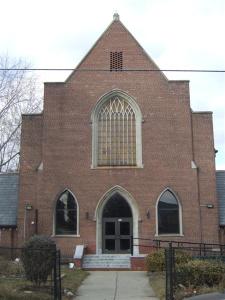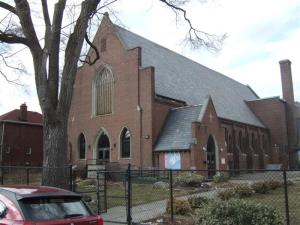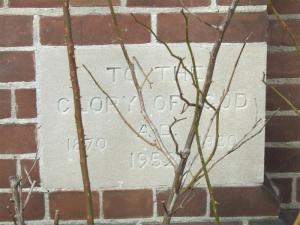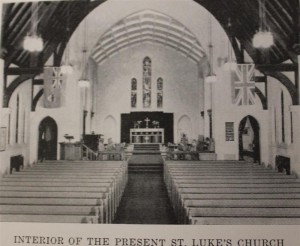St. Andrew’s, Todmorden has the distinction of being known as “The Church Built in a Day”.
It also has the distinction of being (as far as I know) the only Anglican church in the city of Toronto whose site is now occupied by a McDonald’s. (With a historical plaque affixed to it, no less!)
`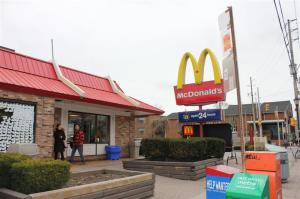
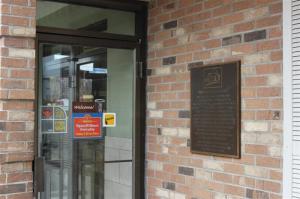
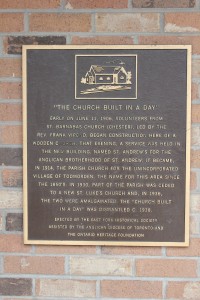 The historical plaque tells the story in brief. (Double-click on any of the photographs to enlarge.)
The historical plaque tells the story in brief. (Double-click on any of the photographs to enlarge.)
The village of Todmorden developed in the nineteenth century around the Todmorden mills in the Don Valley. In the early years of the twentieth century, the Reverend Frank Vipond, who was then rector of St. Barnabas Church, became seized with the need to provide an Anglican presence in Todmorden, which was then very much ‘out in the country’. (At the time, St. Barnabas was located on Ellerbeck Street, just north of Danforth Avenue, three blocks west of its current location at Danforth and Hampton.)
At first, “cottage services’ were held in homes in the area. In 1906, with no assistance from the diocese to build a church proper forthcoming, Mr. Vipond decided to take matters into his own hands. Land was purchased on what is now the north-east corner of Pape & Cosburn, and stained glass windows were procured, some from the former St. Clement’s, Leslieville and three small windows from St. James’ Cathedral. Vipond asked a man named Bob Luxton, who was president of the Chapter of the Brotherhood of St. Andrew at St. Barnabas, to draw up some ‘back of the envelope’ drawings, and the call for volunteer labour went out.
On St. Barnabas Day, June 11th, 1906, workers began arriving at 5 a.m. Shortly before 6 a.m. an open air service was held after which work began. By 8.30 pm, with dusk coming, 150 people crammed themselves into a church designed to hold one hundred, the doxology was sung and a service was held.
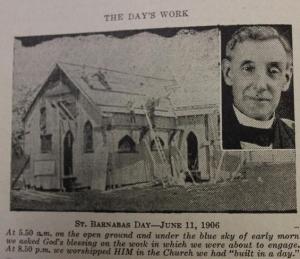
The photograph below shows the three small windows which had come from St. James’ Cathedral.
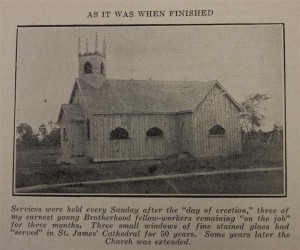
St. Andrew’s became an independent parish in 1914. This photograph shows how the original St. Andrew’s building was subsequently enlarged.

Frank Vipond left St. Barnabas shortly after St. Andrew’s was built, becoming the secretary to Bishop Sweeny, the Bishop of Toronto, and then serving as a military chaplain during and after the First World War. In an unusual move, he returned to St. Andrew’s as rector in 1930, some twenty-four years after having overseen its construction. He was dismayed with what he found — a dwindling congregation facing closure, situated in an neighbourhood which had grown substantially.
Once again, Vipond took matters into his own hands, proposing that a new St. Andrew’s be built, at a different location, further away from the new St. Luke’s just down the road. (In the late 1920s, efforts had been made to amalgamate St. Andrew’s with the new St. Luke’s, which was located on Bay Street but looking to relocate out of the changing downtown core. St. Andrew’s resisted these plans and, in 1930, part of its parish was carved out and given to the new St. Luke’s, located a short distance south on Westwood Avenue. For more information, click on the St. Luke’s, Bay Street link to the right.)
Frank Vipond’s plans were ambitious, as the sketch below shows. His appeal, printed in a long booklet he published to stir up support for a new St. Andrew’s, appealed very directly to those who had been part of the founding of St. Andrew’s in 1906: “I appeal to you who were my co-workers here at the beginning and who are still here,… and to those you who are coming back to bring again into this great work to which you, as well as I, are called, that great spirit of determination and consecrated earnestness which marked your labour for the Church a quarter of a century since.”
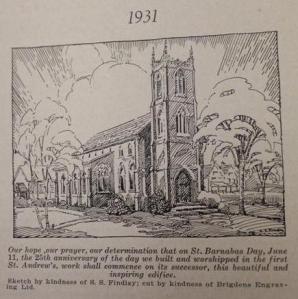
It was not to be. Whether as a result of its over-ambition, or the advent of the Great Depression, or both, by the mid-1930s St. Andrew’s was in serious debt, with newspaper notices to its creditors (including Frank Vipond) being published. In 1936 St. Andrew’s was amalgamated with St. Luke’s, taking on the name St. Andrew & St. Luke’s until 1952 or 1953, after which the name St. Andrew’s disappeared. (St. Luke’s parish continues today in its third location, at the corner of Coxwell and Cosburn.) The “church built in a day” was demolished in the late 1930s.
